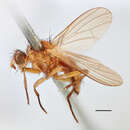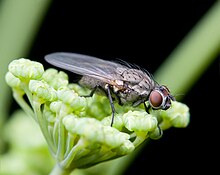en
names in breadcrumbs


The Anthomyiidae are a large and diverse family of Muscoidea flies. Most look rather like small houseflies, but are commonly drab grey. The genus Anthomyia, in contrast, is generally conspicuously patterned in black-and-white or black-and-silvery-grey. Most are difficult to identify, apart from a few groups such as the kelp flies that are conspicuous on beaches.
The name Anthomyiidae was derived from Greek anthos (flower) plus myia (a fly).
Some species are commonly called "root-maggots", as the larvae are found in the stems and roots of various plants. As larvae, some also feed on decaying plant material. The well-known grey "seaweed flies" or "kelp flies" (Fucellia) are examples.[2] Others are scavengers in such places as birds' nests; yet other species are leaf miners; the family also includes inquilines, commensals, and parasitic larvae.
Some species in the family are significant agricultural pests,[3] particularly some from the genus Delia, which includes the onion fly (D. antiqua), the wheat bulb fly (D. coarctata), the turnip root fly (D. floralis), the bean seed fly (D. platura), and the cabbage root fly (D. radicum).
In some contexts, like mountain environments, the adults can be common flower visitors,[4] also being involved in pollination. [5]
For terms see Morphology of Diptera
These flies are small or moderate in size. Hypopleural bristles found on the sides of the thorax are apical. The anal vein of the wing reaches the margin of the wings (except in Chelisia). The median vein is straight, not curved towards the anterior alar margin. Three pairs of postsutural dorsocentral bristles almost always are present. The first segment of the posterior tarsi are on the lower side near the base with minute bristles. The sternopleuron lower side often has short, soft hairs. Eyes in the male in most cases are close-set or contiguous. Females of many species are not known as of yet.
 Adia cinerella
Adia cinerella  Anthomyia pluvialis
Anthomyia pluvialis The Anthomyiidae are a large and diverse family of Muscoidea flies. Most look rather like small houseflies, but are commonly drab grey. The genus Anthomyia, in contrast, is generally conspicuously patterned in black-and-white or black-and-silvery-grey. Most are difficult to identify, apart from a few groups such as the kelp flies that are conspicuous on beaches.
The name Anthomyiidae was derived from Greek anthos (flower) plus myia (a fly).
Some species are commonly called "root-maggots", as the larvae are found in the stems and roots of various plants. As larvae, some also feed on decaying plant material. The well-known grey "seaweed flies" or "kelp flies" (Fucellia) are examples. Others are scavengers in such places as birds' nests; yet other species are leaf miners; the family also includes inquilines, commensals, and parasitic larvae.
Some species in the family are significant agricultural pests, particularly some from the genus Delia, which includes the onion fly (D. antiqua), the wheat bulb fly (D. coarctata), the turnip root fly (D. floralis), the bean seed fly (D. platura), and the cabbage root fly (D. radicum).
In some contexts, like mountain environments, the adults can be common flower visitors, also being involved in pollination.